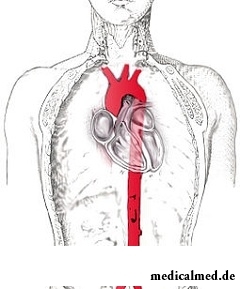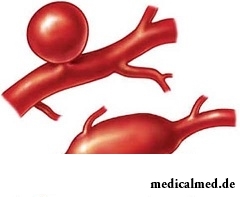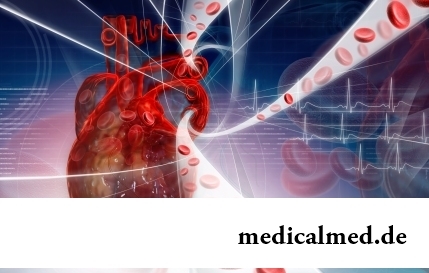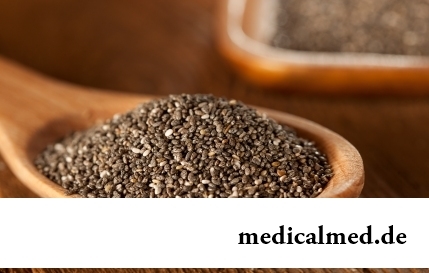





Chest aorta
Chest aorta – the biggest artery in a body which bears blood from heart.
It is located in a thorax therefore call it chest.
Structure of a chest aorta
The chest aorta is located in a postmediastinum and adjoins to a rachis. It is divided into two types of branches: pristenochny and splanchnic.
Treat splanchnic branches of a chest aorta:
- Esophageal branches which in number of 3-6 are directed to a gullet wall. They branch the ascending branches anastomosing with the left ventricular artery and also descending anastomosing with the lower thyroid artery.
- Bronchial branches which in number of the 2nd and more branch with bronchial tubes. They supply with lung tissue blood. Their trailer branches approach bronchial lymph nodes, a gullet, a pericardiac bag and a pleura.
- Pericardiac сумочные or pericardiac branches which are responsible for supply of blood to a back surface of a pericardiac bag.
- Mediastinal or mediastinal branches, small and numerous which feed bodies of a mediastinum, lymph nodes and connecting fabric.
The group of pristenochny branches of a chest aorta consists from:
- Back intercostal arteries in number of 10 couples. 9 of them take place in intercostal spaces, from the 3rd to the 11th. The lower arteries lie under the twelfth edges and are called subcostal. Each of arteries is divided into a spinal branch and into a dorsal branch. Each intercostal artery at heads of edges branches on the front branch feeding direct and wide muscles of a stomach, intercostal muscles, a mammary gland, breast skin, and the back branch supplying with blood of a muscle and back skin, and also a spinal cord.
- Upper phrenic arteries of a chest aorta in number of two pieces which provide with blood an upper surface of a diaphragm.
Arteries of a chest cavity
- Aortic arch;
- Vertebral artery;
- Left and right general carotid arteries;
- The highest intercostal artery;
- Renal artery;
- Aorta;
- General hepatic artery;
- Left subclavial artery;
- Intercostal arteries;
- Upper mesenteric artery;
- Right subclavial artery;
- Lower phrenic artery;
- Left gastric artery.
The most widespread diseases of a chest aorta
Aneurism and atherosclerosis of a chest aorta belong to the most frequent diseases of a chest aorta.
Atherosclerosis of a chest aorta develops, as a rule, before other forms of atherosclerosis, but the long time can not be shown in any way. Often it develops along with atherosclerosis of coronary arteries of heart or atherosclerosis of head vessels of a brain.
The first symptoms of atherosclerosis are, as a rule, shown at the age of 60-70 years when aorta walls already substantially underwent destruction. Patients complain of the periodic arising thermalgias in a thorax (aortalgiya), on increase in systolic pressure, swallowing difficulty, dizziness.
Often less specific characters of atherosclerosis of a chest aorta is aging and emergence of a gray hair, fatty tumors on a face, a light strip on the outer edge of an iris of the eye of eyes, the strong growth of hair in ears too earlier.
One of the most dangerous complications of atherosclerosis is the aortic aneurysm.
Aneurism of a chest aorta is called the state at which its weak part sticks out or extends. Leads pressure of the blood going through an aorta to its vypiraniye.
Aneurisms constitute serious danger not only to health, but also to the patient's life as aortas can become torn that will lead to internal bleeding and a lethal outcome. Approximately to 30% of patients with a rupture of aneurism, coming to hospital, survive. For this reason the aneurysm of a chest aorta needs to treat to avoid a gap.
Approximately a half of patients with aneurism has no symptoms of a disease. Generally people show complaints to back pains and breasts, in a neck, a back and a jaw. There is a complicated breath, cough, hoarseness of a voice.
At big aneurism the aortal heart valve therefore there is heart failure can be involved in process.
Are the most common causes of developing of aneurism of a chest aorta:
- Inborn diseases of connecting fabric (Marfan's syndrome, Elersa-Danlo), cardiovascular system (aorta coarctation, heart diseases, aorta isthmus crimpiness).
- Such acquired diseases as atherosclerosis, or after operations on places of a kanyulyation of an aorta, patches of an aorta or suture lines of an anastomosis of prostheses.
- Inflammatory diseases (aorta prosthesis infection, noninfectious and infectious aortrita).
During life the average person develops neither more nor less two big pools of saliva.

The state of health of the person in many respects depends on chemical composition of biological liquids of an organism. Specialists consider that з...
Section: Articles about health
Practically each person is familiar with the annoying, pulling, unscrewing pains caused by overcooling of muscles of a back. In certain cases inflammatory process is not limited to discomfort, being followed by emergence of hypostasis, consolidations, increase температ...
Section: Articles about health
Each person supports all life a SARS about 200 times. The peak of incidence falls on cold season, but it is possible to get sick with a temperature and a pharyngalgia, and sometimes and very possibly, even during a heat. The reasons for development of catarrhal diseases there is a set: from the weakened immunity till an excess portion of ice cream....
Section: Articles about health
The chia plant, or the Spanish sage, is from South America. The indigenous people of the continent since ancient times used in food it семена:...
Section: Articles about health
Iodine - one of thirty most important microelements in our organism. The main role of iodine consists in synthesis of thyroid hormones of a thyroid gland - the substances which are responsible for the majority of exchange processes of an organism. It is known that thyroid hormones consist...
Section: Articles about health
The brain of the person is studied not one hundred years, but the quantity of the riddles connected with this body increases rather, than decreases. Perhaps, numerous delusions concerning a structure and functioning of a brain are explained by it, many of which arose long ago, but continue to exist and today. Such we are ready to acquaint readers with the most widespread myths....
Section: Articles about health
According to data of World Health Organization, the cataract is diagnosed almost for 7% of the population of Earth. Statistics we get sick...
Section: Articles about health
Eyes – one of the most vulnerable areas on a face therefore age changes concern them first of all. Whether it is possible to keep look youth for many years and what procedures are offered for achievement of this purpose by cosmetologists? And maybe, only thing of a vari...
Section: Articles about health
An eye of the person daily experiences considerable strain. The problem of preservation of sight is for many years directly connected with a question of supply of tissues of eye enough oxygen and nutrients. This task is carried out by small vessels – capillaries. For normal functioning of the visual device extremely important that they kept the integrity, but it works well not always. Microtraumas of eye vessels during which there are small hemorrhages it is extraordinary расп...
Section: Articles about health
Bulimia and anorexia, are heavy deviations of a feeding behavior, become a cause of death of patients much more often than all others...
Section: Articles about health
Each of us faces from time to time that other people need the immediate help. We react to it differently: one at once call doctors and police, others rush to victims and try to save them independently. Some at all...
Section: Articles about health
The summer of this year in Russia was very ambiguous. Regions suffered from a merciless heat, from pouring rains, the hail from time to time dropped out, then there was again a heat which alternated with rainfall again. Many people suffer from such sharp changes of weather. Even flu epidemics and a SARS were recorded....
Section: Articles about health
Stability of a hormonal background is one of the most important conditions of preservation of health of the woman. At the same time endocrine system –...
Section: Articles about health
Life expectancy in various regions of Earth is not identical. Social stability, economic wellbeing, availability and level of medical care, household comfort, literacy of the population in the field of observance sanitary гигиен exert impact on it...
Section: Articles about health
The stroke is one of the most widespread diseases of the person, annually in the world about 6 million cases of this pathology are registered. According to medical statistics, strokes occur almost three times more often than myocardial infarctions. The disease belongs to heavy, and has an unfavourable result: the lethality reaches 40% among women and 25% among men. A considerable part of the patients who endured a stroke cannot be recovered completely. We suggest readers to examine...
Section: Articles about health
Memory is an ability of the central nervous system to fix, keep and as necessary to reproduce information on knowledge...
Section: Articles about health
The person, as well as all other beings living on our planet feels weather changing. It is the normal meteosensitivity which is not causing to healthy people of special troubles. Meteodependence, on the contrary, is morbid condition, характеризующимс...
Section: Articles about health
The endocrine system carries out extremely important role in a human body, practically all processes of life activity are regulated by it. Closed glands (hemadens) produce special biologically active agents – hormones which then get to a blood channel and are transferred to bodies addressees, or as they are called still, to target organs. Frustration of this mechanism are fraught with development of serious chronic pathologies....
Section: Articles about health
Within several decades of our compatriots convinced that the use of butter nasty affects on...
Section: Articles about health
Small appetite at the child – the complaint which pediatricians should hear practically from each mother. Most often it is carried to the category of children's whims, however the refusal of food in certain cases can be to alarming symptoms therefore it cannot be ignored....
Section: Articles about health
Zone hypostases under eyes - very widespread problem giving to people is a lot of inconvenience. Hypodermic fabric in these parts has very loose structure and almost does not contain collagenic fibers. Besides, the skin covering подглазья constantly is exposed to compression and stretching when the person blinks, blinks, etc. These features also create premises for emergence of the so-called bags which are giving to the face a tired and sickly look, and also visually adding increased...
Section: Articles about health
It seems, quite recently you brought the baby from maternity hospital, but time flew by, and here it is already going to join the first...
Section: Articles about health
(Xerostomia) many people consider feeling of a xerostomia small and easily removable inconvenience. This delusion: the symptom can demonstrate existence of serious diseases. It is worth to remember also that saliva performs important functions...
Section: Articles about health
People know that thermal sources have salutary force long ago. Treatment by natural waters is one of the most ancient methods of disposal of the most different diseases. Bathtubs, souls, wrappings and inhalations, in combination with water reception inside help to improve a condition of the patients suffering from disturbances of work of a musculoskeletal system, bodies of digestive tract, cardiovascular, nervous, respiratory and secretory system, skin and endocrine п...
Section: Articles about health
Venereal diseases in medicine are called the infections which are transmitted preferential sexually, now they are so...
Section: Articles about health
According to World Health Organization, every third inhabitant of Earth has excess weight, and every tenth has obesity. The reason of this phenomenon, according to specialists, roots in one not very comforting fact: most of people consume much...
Section: Articles about health
It would seem, to buy drugs in Moscow does not make a problem – a drugstore, and not one, is available for each resident of the capital within walking distance. And, nevertheless, Internet drugstores become more popular – what it is possible to explain such phenomenon with? Actually there is a lot of reasons and if to formulate them it is short, then the most suitable word will be - "conveniently". We suggest to get acquainted in more detail with pluses and minuses of online drugstores that buying drugs, not to make the wrong choice....
Section: Articles about health
